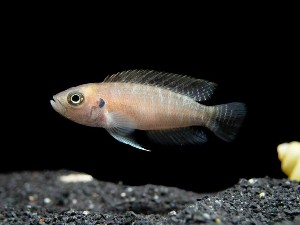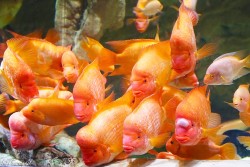Brevis Shell Dweller (Neolamprologus brevis) CareSheet

This shell-dwelling cichlid is a lovely nano species that's simple to raise and reproduce!
The Brevis Shell Dweller (Neolamprologus brevis) is a small shell-dwelling cichlid native to Africa's Lake Tanganyika's deep shoreline areas. It has grown more popular in the aquarium hobby in recent years, although it is still rather uncommon because to its sluggish development rate and tiny spawn size. It eggs in the empty shells of Neothauma tanganyicense snails in the wild. When in mature breeding state, this fish's overall colour is white or silver with a lot of blue and gold tints. Males mature at a considerably faster rate than females.
The Brevis Shell Dweller will flourish in a minimalist aquarium. It should be given with multiple empty shells, which do not have to be of the Neothauma tanganyicense species, since it is a shell-dweller. Mature fish will often claim and defend a small region around their home shells. Because this cichlid enjoys digging, a deep sand substrate bed should be supplied if feasible. This species is modest in size, yet it is very territorial when it comes to its own kind and related fish. During spawning, territoriality is usually at its height. The Brevis Shell Dweller should not be housed with dwarf shrimp or other tiny, sensitive invertebrates. If spawning is desired, other species should be kept to a minimum or avoided entirely unless the aquarium is large enough with enough of cover and decor.
For the uncomplicated Brevis Shell Dweller, feeding is a breeze. Dry, frozen, and live meaty items of high quality will all be welcomed. This species should not be fed dry items entirely since quality and diversity are the keys to a diet that will guarantee that it maintains maximum health and colour.
Requirements for keeping Neolamprologus brevis
Temperature: 75° - 81° F
pH: 7.5 - 9.0
KH: 8 - 25 dKH
Minimum tank size: 10-15 gallons for an adult pair
Origin: Indigenous to Lake Tanganyika, Africa
Average adult size: 2.4 inches for males, 1.6 inches for females

Quick preview - Neolamprologus brevis has arrived
What is the natural habitat of Neolamprologus brevis?
Neolamprologus brevis is native to Lake Tanganyika in East Africa, where it inhabits rocky shorelines and caves. They are often found in sandy areas near rocks and shells, which they use as shelters.
What is the typical size of Neolamprologus brevis?
Neolamprologus brevis is a small cichlid species, with adults reaching an average size of about 2 to 2.5 inches (5-6.5 cm) in length.
Are Neolamprologus brevis suitable for a community aquarium?
Neolamprologus brevis is not always the best choice for a typical community aquarium due to their territorial behavior, especially during breeding. They are best kept in a species-specific tank or with other Tanganyikan cichlid species that share their water requirements.
What are the water parameters preferred by Neolamprologus brevis?
Neolamprologus brevis thrives in water conditions that replicate their natural habitat. Aim for a pH level between 7.8 and 9.0, a water temperature of 75-82°F (24-28°C), and maintain moderate to high water hardness (10-20 dGH).
What should I feed Neolamprologus brevis?
Neolamprologus brevis is omnivorous and can be fed a diet that includes high-quality cichlid pellets or flakes, live or frozen foods like brine shrimp, bloodworms, and small crustaceans. It's important to provide a varied diet to ensure their nutritional needs are met.
How do I set up the perfect aquarium for Neolamprologus brevis?
To create an ideal habitat for Neolamprologus brevis, use a sandy substrate, plenty of rocky hiding places, and shells or clay pots as potential breeding sites. Adequate filtration and regular water changes are essential to maintain water quality.
Can Neolamprologus brevis be kept in pairs or groups?
Neolamprologus brevis can be kept in pairs or small groups, but they are generally territorial, especially when breeding. If keeping more than one pair, provide enough hiding spots and territory to reduce aggression.
How do I differentiate between male and female Neolamprologus brevis?
In Neolamprologus brevis, males are typically larger and more colorful than females. During breeding, males may develop more elongated dorsal fins and exhibit more intense coloration.
What is the breeding behavior of Neolamprologus brevis?
Neolamprologus brevis are cave spawners. The female lays her eggs in a sheltered location, such as a shell or crevice, and the male guards and protects the eggs until they hatch. The fry are usually guarded by both parents and can be fed on newly hatched brine shrimp or crushed flakes.
Are there any potential health issues to watch out for in Neolamprologus brevis?
Like all fish, Neolamprologus brevis are susceptible to common aquarium diseases such as ich (white spot disease) and bacterial infections. Ensure proper water quality, diet, and regular observation to catch any health issues early. Quarantine new fish before introducing them to an established tank to prevent disease outbreaks.
 This shell-dwelling cichlid is a lovely nano species that's simple to raise and reproduce!
This shell-dwelling cichlid is a lovely nano species that's simple to raise and reproduce!



